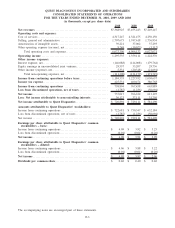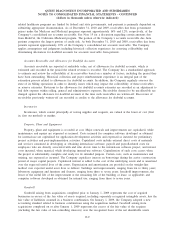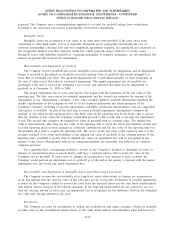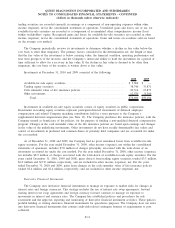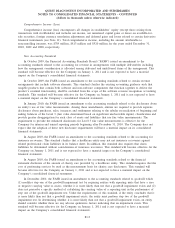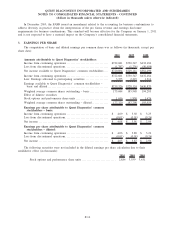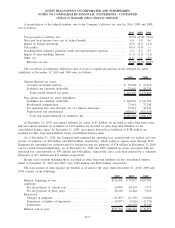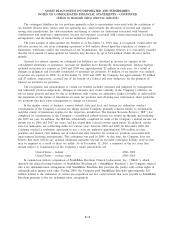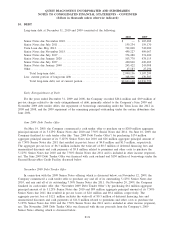Quest Diagnostics 2010 Annual Report Download - page 78
Download and view the complete annual report
Please find page 78 of the 2010 Quest Diagnostics annual report below. You can navigate through the pages in the report by either clicking on the pages listed below, or by using the keyword search tool below to find specific information within the annual report.Interest Rate Risk
The Company is exposed to interest rate risk on its cash and cash equivalents and its debt obligations.
Interest income earned on cash and cash equivalents may fluctuate as interest rates change; however, due to their
relatively short maturities, the Company does not hedge these assets or their investment cash flows and the
impact of interest rate risk is not material. The Company’s debt obligations consist of fixed-rate and variable-rate
debt instruments. The Company’s primary objective is to achieve the lowest overall cost of funding while
managing the variability in cash outflows within an acceptable range. In order to achieve these objectives, the
Company has entered into interest rate swaps. Interest rate swaps involve the periodic exchange of payments
without the exchange of underlying principal or notional amounts. Net settlements between the counterparties are
recognized as an adjustment to interest expense.
The Company formally documents its hedge relationships, including identifying the hedging instruments and
the hedged items, as well as its risk management objectives and strategies for undertaking the hedge transaction.
On the date the derivative is entered into, the Company designates the type of derivative as a fair value hedge or
cash flow hedge, and accounts for the derivative in accordance with its designation as prescribed by the standards
on accounting for derivative instruments and hedging activities. At inception and at least quarterly thereafter, the
Company formally assesses whether the derivatives that are used in hedging transactions are highly effective in
offsetting changes in the fair value or cash flows of the hedged item. All components of each derivative financial
instrument’s gain or loss are included in the assessment of hedge effectiveness.
The Company accounts for its derivatives as either an asset or liability measured at its fair value. The fair
value is based upon quoted market prices obtained from third-party financial institutions and includes an
adjustment for the credit risk of the obligor’s non-performance. For a derivative instrument that has been formally
designated as a fair value hedge, fair value gains or losses on the derivative instrument are reported in earnings,
together with offsetting fair value gains or losses on the hedged item that are attributable to the risk being
hedged. For derivatives that have been formally designated as a cash flow hedge, the effective portion of changes
in the fair value of the derivatives is recorded in accumulated other comprehensive income (loss) and the
ineffective portion is recorded in earnings. Upon maturity or early termination of an effective interest rate swap
designated as a cash flow hedge, unrealized gains or losses are deferred in stockholders’ equity, as a component
of accumulated other comprehensive income (loss), and are amortized as an adjustment to interest expense over
the period during which the hedged forecasted transaction affects earnings. If it is determined that a derivative
ceases to be a highly effective hedge, the Company discontinues hedge accounting and any deferred gains or
losses related to a discontinued cash flow hedge shall continue to be reported in accumulated other
comprehensive income (loss), unless it is probable that the forecasted transaction will not occur. If it is probable
that the forecasted transaction will not occur by the originally specified time period, the Company discontinues
hedge accounting, and any deferred gains or losses reported in accumulated other comprehensive income (loss)
are classified into earnings immediately.
Foreign Currency Risk
The Company is exposed to market risk for changes in foreign exchange rates primarily under certain
intercompany receivables and payables. Foreign exchange forward contracts are used to mitigate the exposure of
the eventual net cash inflows or outflows resulting from these intercompany transactions. The objective is to
hedge a portion of the forecasted foreign currency risk over a rolling 12-month time horizon to mitigate the
eventual impacts of changes in foreign exchange rates on the cash flows of the intercompany transactions. As of
December 31, 2010, the total notional amount of foreign currency forward contracts in U.S. dollars was $55.9
million and principally consist of contracts in Swedish krona and British pounds. Notional amounts represent the
face amount of contractual arrangements and the basis on which currencies are exchanged and are not a measure
of market or credit risk exposure. The Company does not designate these derivative instruments as hedges under
current accounting standards unless the benefits of doing so are material. The Company’s foreign exchange
exposure is not material to the Company’s consolidated financial condition or results of operations. The Company
does not hedge its net investment in non-U.S. subsidiaries because it views those investments as long-term in
nature.
F-12
QUEST DIAGNOSTICS INCORPORATED AND SUBSIDIARIES
NOTES TO CONSOLIDATED FINANCIAL STATEMENTS - CONTINUED
(dollars in thousands unless otherwise indicated)



